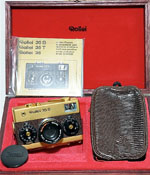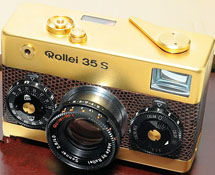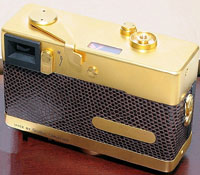The Common Rollei 35 Cameras

By James Vilett (2010) ©
The Rollei 35 series of cameras were a top quality line of compact pocket cameras. When early models were first introduced in 1966 these cameras were ultra compact for the day. The first 1966 cameras said “Made in Germany by Rollei - Compur - Gossen - Zeiss” in the chrome at the bottom of the camera back. Early 1966 cameras are uncommon. Actual mass production models started selling in 1967. The Rollei 35 model serial numbers started at 3,000,000. For a long time (until 1975) there was nothing as small or as good on the market. Even after 1975 the other competing compact cameras were just not in the same class as the Rollei 35 cameras. A high percentage of each Rollei 35 camera was made of metal; with a metal top cover, a metal back, all internal metal advance gearing, and an all metal shutter. Many of these cameras are still in use today with little or no servicing. A good CLA makes most of these unserviced machines as good as new and is well worth doing. The top quality Zeiss optics allowed people to get beautiful prints; with even 8x10 and larger prints showed stunning definition. Users were able to overlook the fact that the flash shoe and counter were on the bottom of the camera. The $189.50 cost was pretty steep for the mid-1960’s; but despite the high cost large numbers of these cameras were sold by Rollei. These user/classic cameras were mass-produced from 1967 until 1982. The Singapore production plant closed in 1982. Other special edition models were being made up until 1997. (The last of the factory parts are being assembled in Germany by the last Rollei 35 specialist for one last special edition.) The special edition cameras are highly desirable and are often available but are still a steep price. Some of these models include gold (Rollei 35, 1971-72), gold (Rollei 35S, 1974-76), silver (1979), platinum (1986), titanium (1992), and Royal (gold, 1995). All these special editions are nice for a collector but not so good for actual use. Most of these special cameras never get used. The West German gold Rollei 35 camera made between 1971– 1972 is one of the more desirable hard to find models.
Over the years there were 8 mass produced models which are still commonly available. These common models include:
- Rollei 35 1966 model (uncommon)
- Rollei 35 1967-1975
- Rollei B35 1969-1978
- Rollei C35 1969-1971 (the only non-metered ‘budget’ model) $139.50.
- Rollei 35S 1974-1980
- Rollei 35T 1976-1980
- Rollei 35 LED 1978-1980 (an economy model with an inexpensive lens)
- Rollei 35 TE 1980-1982
- Rollei 35 SE 1980-1982
Common mass produced models are still readily available to the average user at good prices. If you have extra money you certainly should spend it on a gold or silver plated model for your every day photographs. In 1975 and 1976 Rollei switched its production of Rollei 35 cameras from West Germany to a Singapore plant. Cameras made in West Germany used Zeiss German made optics. Cameras made in Singapore had Zeiss lenses made under license by Rollei. Most of the Singapore cameras are as well made and as well finished as the original German made Rollei 35 cameras. In actual use these cameras produce high quality pictures, and work just as well as the German made models.
The first German cameras were about the size of a pack of cigarettes with a folding 40mm f3.5 four element Zeiss Tessar lens with f stops to f22. (Other similar optics included the 50mm f3.5 Leica Elmar lens and the famous Kodak Ektar series of lenses.) The original Rollei 35 lens was produced in West Germany by Zeiss, and was a four element lens with the rear two elements being cemented together. Zeiss produced an optic with four elements in three groups (the standard Tessar design). Up until 1920 Zeiss had a monopoly on the Tessar design. Other manufacturers got around this by making variations in the original design (the Ross Xpress is an example of a modified Tessar). Over the years there have been many lenses which used the Tessar design that were produced by different manufacturers. These optics are low cost to produce, and if well manufactured will produce nice photographs. Zeiss designed Tessar type lenses were of very high quality and produced excellent photographic results. When the camera was cocked the front lens barrel could be turned and pushed into the camera body. These lenses barrels were often forced into the body without first cocking the camera. This broke many Rollei 35 cameras. Most of the lens coupling levers, and the main shutter mechanism, are directly behind the leather covered front of the camera. If the front was hit the levers often got bent and would no longer work correctly. When the cameras got wet rust quickly froze up all these mechanisms. The camera shutter was mechanical with speeds from ½ - 1/500th of a second plus B. The original model had a coupled CDS meter which worked very well. The camera tops were made of thin metal. When dropped these tops dented easily. There was a top plastic window you had to look at in order to set the camera meter. This required setting the meter while looking down on the top of the camera. In order to do this you had to remove your eye from the viewfinder window. Changing the shutter speeds and f stops required looking at the front of the camera. The f stop dial had a lever lock which had to be pushed to change f stops. Focusing was done by estimation; you looked at the top of the lens and guessed the footage you needed to set. Since the cameras were simply beautiful well designed machines that took wonderful pictures they sold despite these small drawbacks. They were designed for the amateur market and photographers loved them. Each camera model came in either black or chrome being produced at various times. The first Rollei 35 model was produced in both Germany and Singapore, so you are liable to find either version. All the very first models were produced in Braunschweig with a chrome finish. (A black made in Germany models was available later.) The first US distributor of these early cameras was Honeywell Photographic Products. Many of the early US imported cameras have a small metal label on the back that say Rollei HONEYWELL. The lower back of the camera is marked “Made in Germany by Rollei”.
Starting in 1974 the Rollei 35S was produced in Singapore. This camera was pretty much identical to the original Rollei 35. A Zeiss designed Sonnar 40mm f2.8 lens was used on this model. It had five elements and was produced by Rollei. This particular lens is tack sharp. You may easily get prints of high quality up to 16x20 with this fine optic. If you’d like to shoot wonderful film pictures with a quality camera the Rollei 35 pocket cameras would be a great choice.
- Early
Rollei 35 - Black
Rollei 35 - Chrome
Rollei 35 - Chrome
Rollei B35 - Chrome
Rollei 35S - Chrome
Rollei 35T - Chrome
Rollei 35TE - Gold
Rollei 35S
An early Rollei 35.........
with a 40mm f3.5 Tessar lens. These early optics were made by Zeiss in Germany. A black German version became available in 1968.
Black Rollei 35..............
These came with a Rollei produced (Zeiss designed) 40mm f3.5 Tessar lens. This version was made in Singapore between 1974 and 1975.
Rollei 35 chrome............
with the 40mm f3.5 Tessar lens designed by Zeiss produced by Rollei. This Singapore model was made between 1974 and 1975.
Rollei B35... ...German version with a 40mm f3.5 Triotar Lens. These models were made between 1969 and 1978. This German model was made prior to 1975.
The Rollei 35 with the Tessar lens was the top model;
the B35 was the intermediate model; and the nonmetered Rollei C35 (also with a triotar lens) was the economy model. The Triotar lens was a simple triplet design similar to the Zeiss Novar or Illex Paragon design. These lenses produced nice quality photographs but were not quite as good as the 40mm f3.5 Tessar lens design. Cameras were either marked B35 or 35B. Models marked 35 B were made in Sinapore.
With an uncoupled selelenium exposure meter..
Rollei 35S with the 40mm f 2.8 Sonnar lens..
This model only came with the 40mm f2.8 Sonnar lens. While there were some early German made models (in chrome only) most were made in Singapore. This camera came in both chrome and black versions. Made between 1974 and 1980. S=Sonnar. This would be one of the best cameras for a user to purchase.
Rollei 35T ... with a 40mm f3.5 Tessar lens.
The Rollei 35T is just the same as the Rollei 35 there is no difference. Made between 1976 and 1980. Available in both black and chrome. All of these were made in Singapore. T=Tessar.
Rollei 35TE.. battery
The Rollei 35TE had a 40mm f3.5 Tessar lens. The Rollei 35SE was just the same but had a 40mm f2.8 Sonnar lens. Both the 35TE and the 35SE had a CDS meter with an LED readout. Made in either black or chrome between 1980 and 1982. TE for Tessar. SE for Sonnar.
 ....
.... ...
... This is not one of the more common models. Plated in 24 Kart gold. About 1500 were made. These came with their own special serial numbers. Covered in lizard skin for import into the USA. Made between 1974 and 1976.
This is not one of the more common models. Plated in 24 Kart gold. About 1500 were made. These came with their own special serial numbers. Covered in lizard skin for import into the USA. Made between 1974 and 1976.